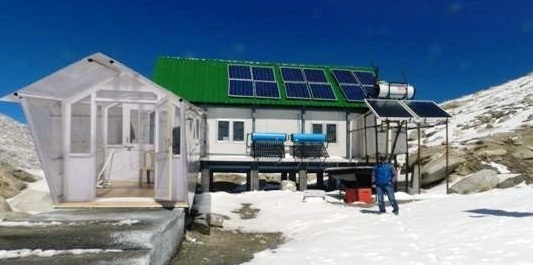SOURCE: AFI


The Defense Institute of High Altitude Research (DIHAR), Leh, under the Defense Research and Development Organization (DRDO), is developing cutting-edge solar thermal warming technology aimed at providing reliable heating solutions for soldiers stationed in extreme weather conditions. This solar thermal heating system is designed to combat the harsh winter conditions in high-altitude regions such as Ladakh, where temperatures can drop as low as -40°C.
The core of this system is based on solar thermal technology, which captures solar energy and transfers it to a heat transfer fluid. The fluid, which is a specially formulated mix of water and organic materials, can operate effectively even in temperatures as low as -40°C. Once the fluid absorbs the heat, it is stored in insulated tanks. The system then regulates the indoor temperature automatically based on sensor inputs, ensuring a stable and comfortable environment for the soldiers.
With just the push of a button, the system works to maintain the temperature within a designated range, typically between 14°C to 20°C. The technology operates efficiently, sensing temperature drops and restarting the heating process when required, offering soldiers a stable and controlled indoor climate despite the freezing external conditions.
One of the most critical concerns in high-altitude regions is the scarcity of sunlight during cloudy days or prolonged periods of low sunlight. To address this challenge, the DRDO has integrated a backup system into the solar thermal technology. This backup uses a heat pump that kicks in when the solar energy is insufficient. Additionally, the system employs an oil with a high boiling point (around 220°C) to store excess heat, ensuring that the system can operate for up to 16 hours without direct sunlight.
This innovation enables soldiers to rely on a consistent heat source, even when weather conditions are less favorable, providing a much-needed boost in energy efficiency and ensuring continuous comfort and safety in the harshest environments.
The solar thermal heating system has been specifically developed for use by Indian Army personnel stationed in high-altitude regions like Ladakh and Siachen, where temperatures plummet during winter. In these challenging conditions, the system is designed to provide much-needed warmth in their habitats.
During trials, the heating system maintained an indoor temperature of 14°C to 20°C, even when the outside temperature dropped to -40°C. This not only improves the comfort levels of soldiers but also reduces their dependence on traditional heating methods, which are often less efficient and harder to maintain in such environments.
The development of this solar thermal heating system marks an important step toward sustainability and energy efficiency in defense infrastructure. By utilizing renewable energy and reducing reliance on conventional fuel-based heating systems, the Indian Army can significantly lower its logistical burden while also decreasing its environmental footprint.